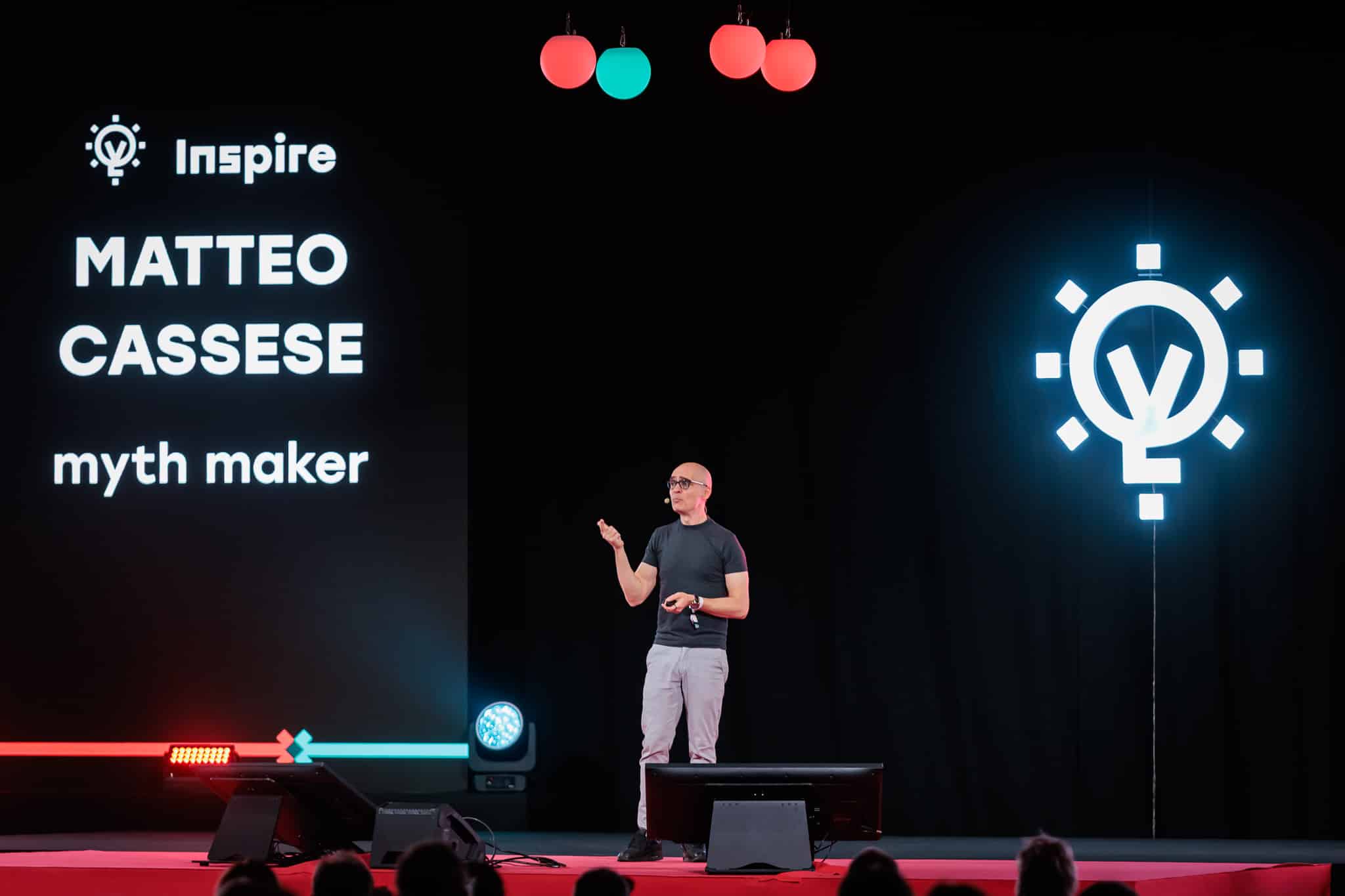In this overview you will learn everything you need to know about Business Storytelling.
I’ll be your guide. I’ve spent the last 2 decades analyzing Hollywood scripts, creating business narratives, teaching presentations and storytelling and delivering inspiring keynotes on stage.
What Is Business Storytelling?
Business storytelling means using narrative structure to communicate, collaborate, and market more effectively, both inside and outside the organization.
From persuading colleagues and clients to repositioning your company in the market, storytelling creates emotional and strategic alignment.
Storytelling works because it makes your message more real and human. It helps you say what matters without sounding like everyone else.”
Why Storytelling Matters In Business Communication?
Business Storytelling helps people understand and remember things. In business, it makes messages clearer and more powerful.
You can use story structure in ads, talks, company meetings, or even when you’re leading change. Managers and HR teams can use stories to reduce complexity.
Good stories also help in PR and public communication: they can change how people and even lawmakers see things.
If you’re a leader, marketer, or part of a team that needs to explain yourself well, knowing how to use stories can make everything you do work better: emails, presentations, videos, and more.
What Are Some Great Storytelling Examples?
Let’s see three examples of contemporary business storytelling.
“One more thing”: That’s the staple of Steve Jobs’s presentations. By leaving the best for last, he managed to end every presentation on a high note and hold the attention of the audience waiting for a final nugget.
“The TED personal story”: This is a formula used in the opening of most TED talks, where the speaker will relate something intimate and seemingly unrelated to the topic. This will then become a core element of the talk going forward.
“The joke”: Jokes are one of the most widespread forms of storytelling and are often used, especially in advertising. The joke has two components: the setup and the payoff. This is a perfect two-act structure in order to drive home a laugh, or just to break through to the audience and get their attention.
What Are the Best Storytelling Companies?
Tesla: This relatively new car company has captured the imagination of thousands of people by introducing models years in advance of production, calling their functionalities with evocative names like “Autopilot” and “Ludicrous mode”, polarizing with the speeches and acts of their founder Elon Musk.
Disney Pixar: Movies like WALL-E, Up, and Toy Story are the maximum expression of the power of stories. They hook 3-year-olds and 99-year-olds with the same passion by exploiting our lust for adventure, beauty, truth, and love.
Netflix: The streaming giant is using data from its users to generate interesting stories and introducing new concepts. Binge-watching was a consumer behavior observed among the platform data before becoming a global buzzword.
Look at this PR story for example: 2017 A Year in Bingeing
There are many more companies that create a narrative which defines their brand. Volvo: family and safety. Nike: freedom and an active life. Toyota: dependability and no frills. IKEA: simple design at a low price. Samsung: high tech for everyone.
Why Is Storytelling Important?

We’ve been sharing stories around the fire for as long as there has been language. That’s an estimate of 50.000 to 100.000 years.
Throughout the span of human evolution, stories have helped establish how we think, what we believe and how we act in the world.
As we enter the age of computer intelligence, storytelling remains the most relevant and effective tool to spreading ideas, explaining complex topics or persuading others to act.
Storytelling is so powerful because it’s the most natural form of human communication.
If you begin a story, your audience is already hooked: we’re naturally geared to want to hear it till the end.
What Storytelling Techniques Can I Use Everyday?
You can apply storytelling to your business communication in 6 simple steps:
Step 1: Elevate the Stakes.
Before diving into your message, show your audience why it matters, what makes it urgent. Make it clear that what you’re about to say isn’t just relevant: it’s essential.
Step 2: Be the Guide.
You’re not the hero, your audience is. Your role is to guide them, mentor them, help them see the way forward. Tell them why they can trust you.
Step 3: Introduce the Change.
What’s the one thing they need to see differently by the end of the story? What’s the shift in mindset, direction, or behavior? Define it clearly.
Step 4: Explore the Resistance.
No change comes easy. Acknowledge the hesitation, the objections, the voices saying “no.” Make them part of the story. Give your audience permission to feel what they’re already feeling.
Step 5: Introduce the Big Idea
Now that we’ve seen the challenge, return to what needs to change. Restate it. If you’ve done your job well, now your audience can truly grasp it. And act on it.
Step 6: End with Impact.
Don’t explain it to death. Once you’ve landed the point, close clean. Let them sit with it.
In this video I explain this very method with a simple example: how to cook great pasta carbonara.
How Do You Become a Good Storyteller?
What techniques do I need to learn?
The best way is to go to the source and learn the principles of storytelling. The tools of the trade are The Hero With a Thousand Faces by Joseph Campbell and The Writers Journey: Mythic Structure for Writers by Chris Vogler. They provide a story structure that is complex, multifaceted, and bulletproof.
How Does Storytelling Apply to Marketing?
Storytelling is involved in most aspects of marketing. A brand can choose to tell their story in a humble or epic way through storytelling: this means putting the brand in context for the consumer and emphasizing the role of the company in the life of the consumer. This can have an effect on all marketing materials produced by the company.
The company may choose the consumer as the hero, and tell their stories. By highlighting how the brand is an enabler of life experiences for their consumers, the brand is lifted up and comes close to the needs of the users.
Overall, any good marketing material uses storytelling to a certain degree. Every payoff, every headline, every video ad follows the rules of the story arc and thus is an expression of storytelling.
How Can I Apply Business Storytelling to Sales?
Storytelling has the power to evoke sensations and emotions in the minds and souls of the audience. This is exactly what successful salespeople want to do to highlight the need or desire for a product or a service.
Storytelling can help sales teams set the stage, introduce the roles of the product/service, highlight the solutions, show the pitfalls of not having the product/service and the lasting benefits of living with the product/service for a long time.
In this sense, storytelling can help through the first engagements with the prospects, all the way to closing the deal.
Can Storytelling Help in B2B Sales?
What we just said about sales applies both if the company is consumer facing, and if the subject of sales are other companies.
The boardroom is the ideal “campfire” because it’s the theater of so many dry, fact-based presentations. By entering a meeting with a well-structured story to tell, you automatically set yourself at an advantage from your competition.
Can I Use Storytelling Within the Workplace?
Storytelling plays a role within the workplace, as it helps create better relationships and experiences. It also helps spread ideas.
Using narratives to manage conflicts: One of the basic skills that need to be introduced in conflict resolution is the ability to see the object of contention from different perspectives. Stories serve exactly that purpose and enable us to step into the shoes of our counterpart to see their point of view and start releasing the tension of conflict.
Using a narrative to interpret the past and shape the future: Storytelling techniques are used for change management and innovation each time the company needs to spread a new vision for the future, or needs their employees to make sense of an event that happened in the past.
Using a narrative in the reasoning process: The decision making that happens continuously in the workplace can be supported by embedding facts into narratives. This makes the facts more relevant, and easy to grasp and to remember.
What’s next?
The art and science of business storytelling is so deep that we can spend months discussing this.
I always welcome inquiries for storytelling keynotes and business storytelling coaching.
Please also read my in-depth guide on the hero’s journey in business. It’s an illuminating resource with information that is not to be found anywhere else on the web.

